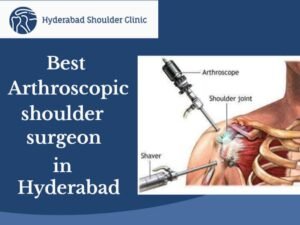Shoulder replacement surgery is a procedure that involves replacing damaged or diseased parts of the shoulder joint with artificial components. It’s typically recommended for individuals suffering from severe arthritis, rotator cuff injuries, or fractures that do not heal properly. During the surgery, the surgeon removes the damaged bone and cartilage from the shoulder and replaces them with a prosthetic joint made of metal and poly.
There are different types of shoulder replacements, including total shoulder replacement (where both the ball and socket are replaced) and reverse shoulder replacement (where the ball and socket positions are switched), often used for patients with rotator cuff problems. The goal of the surgery is to reduce pain, improve shoulder function, and enhance the overall quality of life. Recovery usually involves physical therapy and rehabilitation to regain strength and mobility.
When is shoulder replacement surgery recommended?

Shoulder replacement surgery is typically recommended in the following situations:
- Severe Osteoarthritis: When arthritis causes significant pain and limits movement, and other treatments (like medication or physical therapy) have not been effective.
- Rheumatoid Arthritis: This autoimmune condition can severely damage the shoulder joint, making replacement necessary.
- Rotator Cuff Tear: In cases of a large or irreparable rotator cuff tear, especially when coupled with arthritis or joint pain, a reverse shoulder replacement might be recommended.
- Fractures: If a fracture of the shoulder joint does not heal properly or is deemed too severe for surgical repair, replacement might be the best option.
- Avascular Necrosis: When the blood supply to the shoulder bone is disrupted, leading to bone death and joint deterioration.
A thorough evaluation by an expert shoulder surgeon like Dr.Chandra Sekhar B is essential to determine the best course of action for each case.
Shoulder replacement surgery procedure in a nutshell

Shoulder replacement surgery involves several key steps:
-
- Anaesthesia: The patient is given either regional anesthesia or general anesthesia to numb the shoulder area.
- Incision: The surgeon makes an incision on the front or side of the shoulder to access the joint.
- Removal of Damaged Tissue: The damaged bone and cartilage of the shoulder joint are carefully removed.
- Placement of Prosthetics:
- In a total shoulder replacement, both the ball (humeral head) and socket (glenoid) are replaced with artificial components.
- In a reverse shoulder replacement, the positions of the ball and socket are switched to help improve stability and function, particularly in cases of rotator cuff damage.
- Closure: The incision is closed with sutures or staples, and a sterile dressing is applied.
The entire procedure usually takes about 1 to 2 hours, and patients typically stay in the hospital for a day or two post-surgery, depending on their recovery.
Shoulder replacement surgery recovery explained
Recovery from shoulder replacement surgery typically involves several stages and can vary from person to person. Here’s a detailed overview of what to expect:
Immediate Post-Operative Care
Most patients stay in the hospital for one to two days. During this time, healthcare providers monitor vital signs and manage pain through medication. Pain is common after surgery, and medications (oral or intravenous) will be prescribed to help manage it.
Initial Recovery Phase (Weeks 1-4)
After discharge, patients will likely need assistance at home, especially during the first week. It’s important to keep the surgical site clean and dry. Patients should follow the surgeon’s instructions regarding dressing changes and signs of infection.
Patients will be advised to avoid lifting, reaching overhead, or performing any strenuous activities for several weeks. A sling is often used to support the arm.
Rehabilitation is done with guided exercises to improve mobility and strength.
Intermediate Recovery Phase (Weeks 4-12)
As healing progresses, patients can gradually resume normal daily activities but should still avoid heavy lifting and high-impact activities. The focus of physical therapy shifts to strengthening the shoulder muscles and improving function. Mild pain and swelling can continue, ice and elevation can help manage discomfort.
Long-Term Recovery (3-6 Months)
Many patients regain a significant range of motion and strength by three to six months post-surgery. Patients can usually return to most normal activities. High-impact activities should be discussed with the surgeon.
Continued exercises at home or in physical therapy may be recommended to maintain strength and flexibility.
Shoulder replacement surgery recovery checklist for better results
To achieve the best results after shoulder replacement surgery, patients can follow these guidelines:
Follow Medical Advice
- Adhere to Instructions: Follow all postoperative care instructions from the surgeon, including medication schedules and activity restrictions.
- Attend Follow-Up Appointments: Regular checkups are essential to monitor progress and make any necessary adjustments.
Engage in Physical Therapy
- Start Early: Participate in physical therapy as recommended, even if it begins in the hospital.
- Commit to Exercises: Follow the prescribed exercise regimen diligently to improve your range of motion and strength.
Manage Pain and Swelling
- Use Pain Medications: Take prescribed medications to manage pain effectively.
- Ice and Elevation: Apply ice packs and keep the arm elevated to reduce swelling.
Rest and Recover
- Allow Time for Healing: Ensure adequate rest to facilitate the body’s healing process. Avoid overexertion.
- Use a Sling: Wear the sling as advised to provide support and stability.
Modify Activities
- Avoid HighImpact Activities: Steer clear of heavy lifting and highimpact sports during the initial recovery phase.
- Adapt Daily Tasks: Make adjustments in daily activities to prevent strain on the shoulder.
Maintain a Healthy Lifestyle
- Stay Hydrated and Eat Well: A balanced diet rich in nutrients supports healing. Foods high in protein, vitamins, and minerals are beneficial.
- Avoid Smoking: Smoking can impede healing; quitting can significantly enhance recovery.
Stay Positive and Patient
- Set Realistic Goals: Understand that full recovery takes time. Celebrate small milestones.
- Stay Motivated: Keeping a positive outlook can help maintain motivation during rehabilitation.
Communicate with Your Care Team
- Report Any Issues: Notify your healthcare provider of any unusual symptoms, such as excessive pain, swelling, or signs of infection.
- Discuss Concerns: If you have questions or concerns about your recovery or rehabilitation, don’t hesitate to reach out.
By following these steps, patients can optimize their recovery process and achieve the best possible outcomes after shoulder replacement surgery.
A word from Dr.Chandra Sekhar B from Hyderabad Shoulder Clinic
Regular check-ins with the surgeon are essential to monitor healing and adjust rehabilitation plans. Please adopt a shoulder friendly lifestyle that can help maintain joint health and function over the long term. Following the guidelines that we give at Hyderabad Shoulder Clinic, which are crucial for optimal recovery. Overall, recovery from shoulder replacement surgery is a gradual process, and a well structured rehabilitation plan is key to achieving the best outcomes. For more information, please visit our website https://hyderabadshoulderclinic.com/ or contact us at +91 9959588389 or shoulderandsportsclinic@gmail.com.





